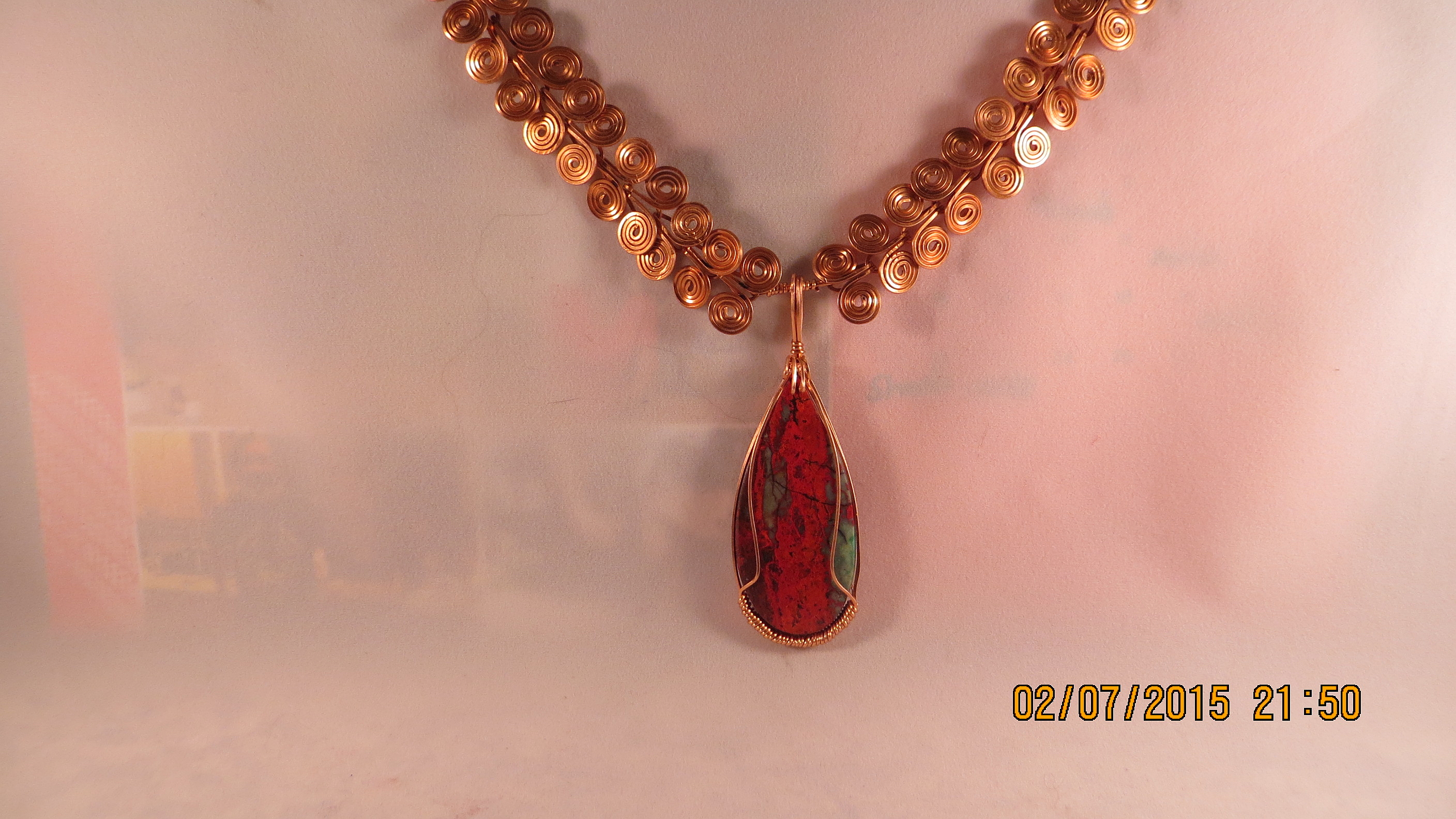Tommy
Administrator 
Member since January 2013
Posts: 12,993
|
Post by Tommy on Feb 24, 2018 11:19:52 GMT -5
I've been needing a small versatile flat lap for getting scratches out of the backside of cabs. I've been using a 'screw-on' flat sander mounted on a poly arbor turned sideways but it's been hell on my fingers and it can sling a cab across the room in a heartbeat. I'm too stubborn to spend any actual money on it so I've had my eyes open for the right 'bones' for a while. I almost bought a large one from Tony catmandewe in Quartzsite a month ago but the more I thought about it I knew I don't have the space for it - and no room in the vehicle to haul it home  . My son recently offered me this old Delta Homecraft platform sander wood and I knew instantly that I had found it. He got it at a garage sale and was going to throw away because he was clearing all his tools and crap out of his mom's house because she sold the house. 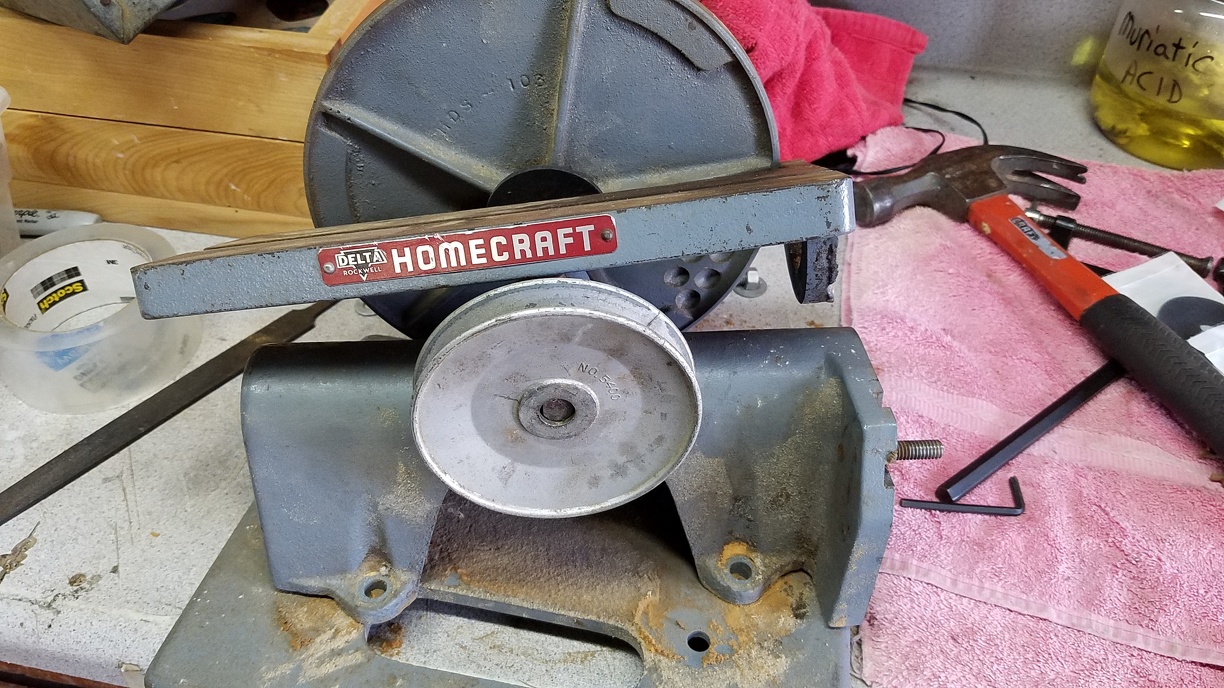 Made some alterations to it - took the bottom plate off and used a grinder to take off the mounting parts for no real reason other than I wanted to. 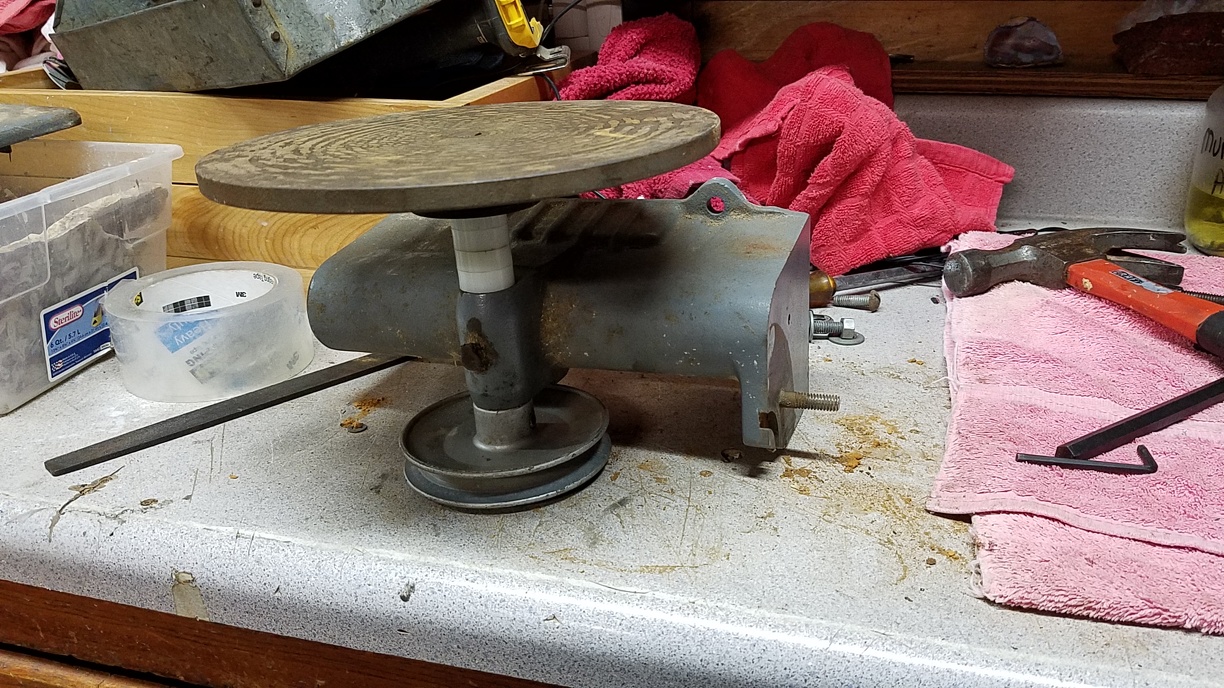 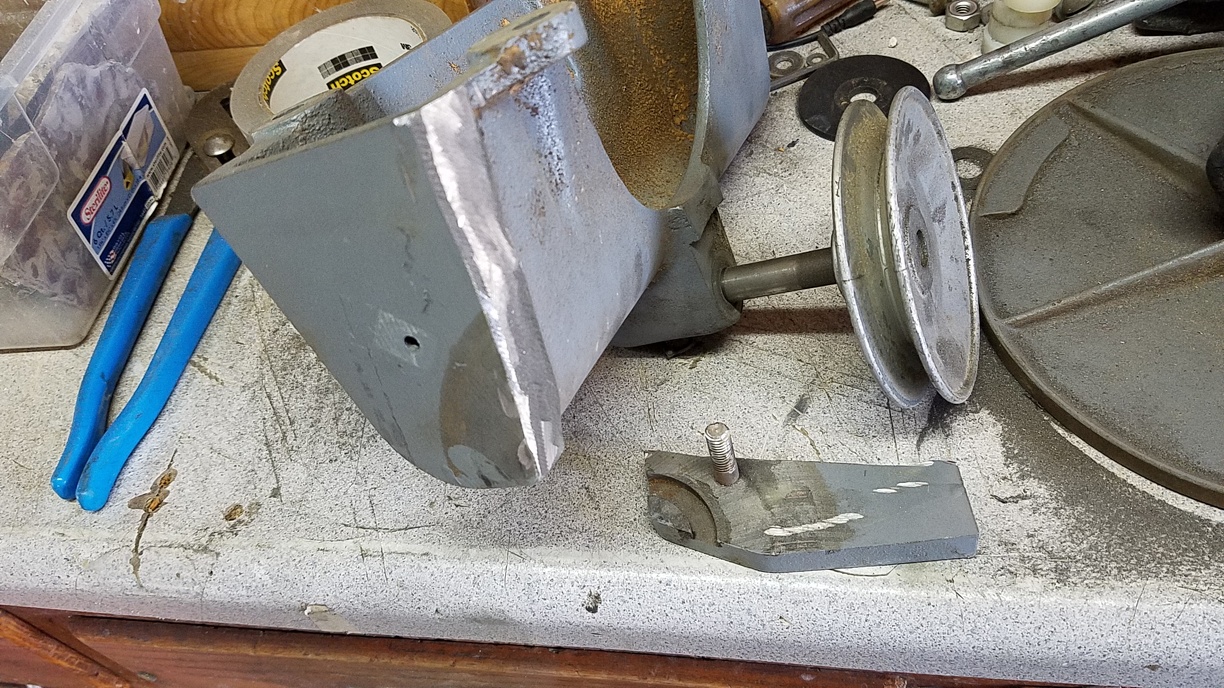 Mounted it to the tiny little section of work space I had available. 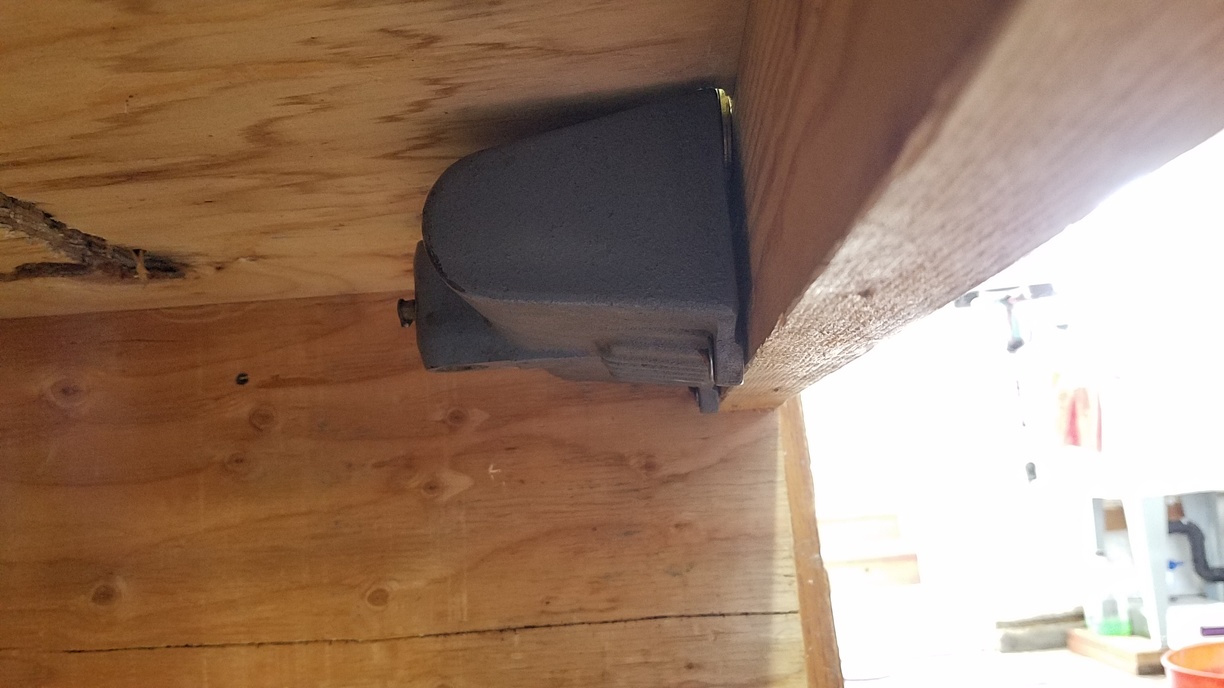 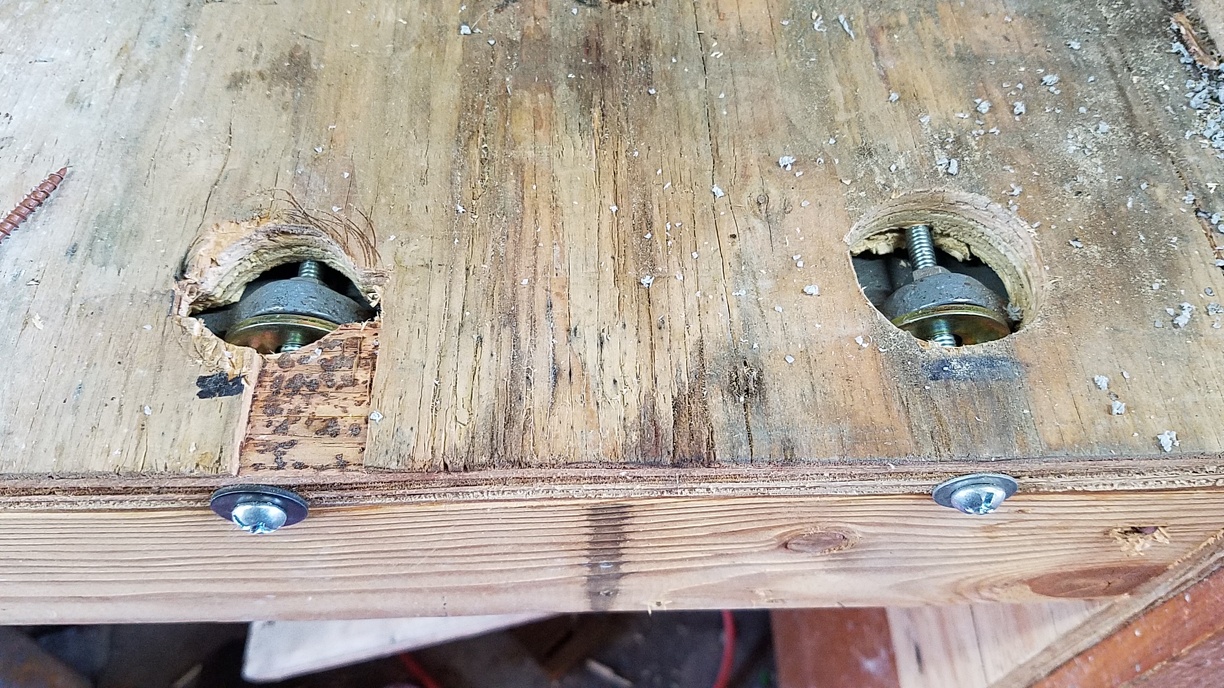 The only thing I had to buy initially was a couple of large rubber washers.  Underside of bucket pan  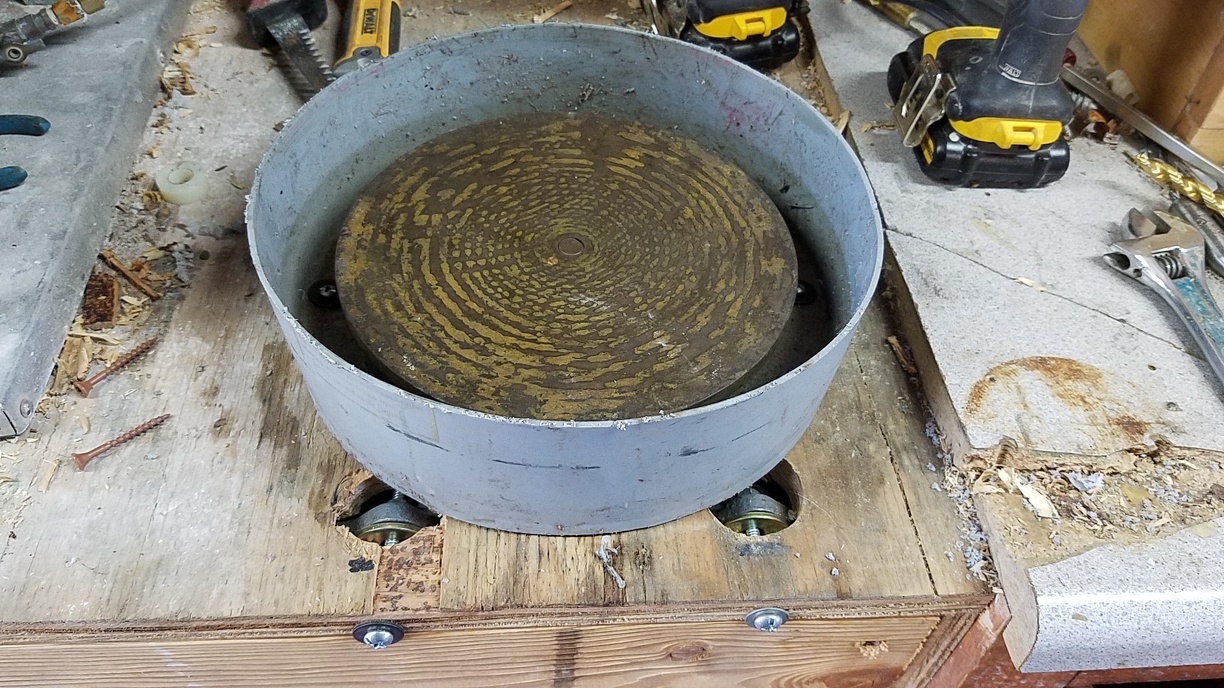 So the basic framework is in place and I'm using it effectively but there are a few things I need to finish up. It took a lot of work getting all the glue off the platen surface and getting it perfectly smooth. I still need to permanently mount my water drip delivery system and add a drain to the pan - I bought the part for it already but haven't installed it yet. I also need to finish up the belt tension system - the metal bar seen in the video is only temporary. I will add pictures to this as it becomes more complete.
Update 2/26 - added the drain I used a sink hole cover - $5 at my local hardware store. The threaded stem is hollow so I drilled a hole through the flat top for a very low profile drain. 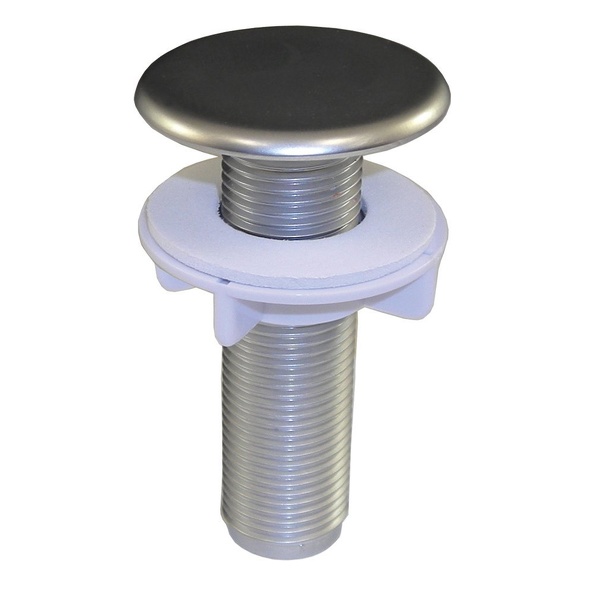 It doesn't show up very well in the picture but the center of the bucket is built up from underneath with the large rubber washers so it is the highpoint of the pan. I used a 1" hole saw to drill the drain at the low point in the pan. It drains into a bucket under the table. 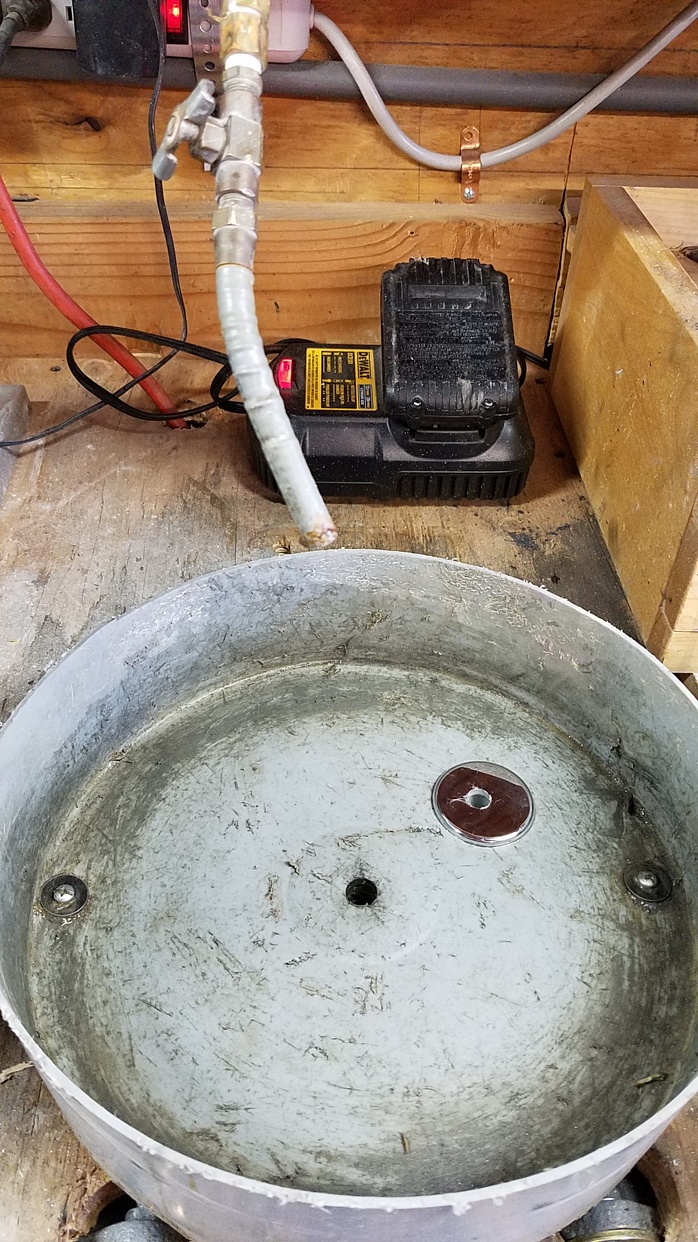 I'm calling it completed! |
|
|
|
Post by Rockoonz on Feb 24, 2018 15:43:55 GMT -5
Looks like it will do the job. Are you going to use a grit slurry or magnetic diamond discs?
|
|
|
|
Post by Jugglerguy on Feb 24, 2018 17:40:15 GMT -5
That looks good. I like the foot pedal switch.
|
|
minerken
Cave Dweller 
Member since August 2013
Posts: 466 
|
Post by minerken on Feb 24, 2018 19:20:09 GMT -5
way to go Tommy it's always a great satisfaction building your own tool and saving tons of hard earned cash |
|
Tommy
Administrator 
Member since January 2013
Posts: 12,993
|
Post by Tommy on Feb 24, 2018 22:33:47 GMT -5
Looks like it will do the job. Are you going to use a grit slurry or magnetic diamond discs? I'm using slurry currently. I bought a lot of bags various grits at an estate sale a few years ago and since I don't tumble very much will seem like a good way to use some of it up. |
|
|
|
Post by Rockoonz on Feb 24, 2018 23:48:30 GMT -5
This just happened to hit the top of my youtube feed, another method that seems intriguing.
Not sure how the fish and cat figure into it, but he got a nice polish.
|
|
|
|
Post by HankRocks on Feb 25, 2018 7:54:32 GMT -5
If that rock slips out of his hand, there is going to be trouble. It may stay in the tire and it may not!! The turn table seems to be turning a bit fast.
Tempted by something like this to do the 1st stage(80 grit) to get the rocks smooth. It seems to take the longest on the Vib Lap, even with "smooth" cuts.
|
|
|
|
Post by Jugglerguy on Feb 25, 2018 8:00:22 GMT -5
I don’t understand how you would avoid ruining the base plate with this “sprinkle the grit on” method. Isn’t the metal disc softer than the rock? What wouldn’t it quickly develop grooves and valleys? If it did, then how would it make rocks flat in the future?
Ok use sandpaper discs that I glue to my flat lap, so the base (most of mine are plywoood) is always protected. I might be missing something with the method in the video,
|
|
Tommy
Administrator 
Member since January 2013
Posts: 12,993
|
Post by Tommy on Feb 25, 2018 11:02:33 GMT -5
I don’t understand how you would avoid ruining the base plate with this “sprinkle the grit on” method. Isn’t the metal disc softer than the rock? What wouldn’t it quickly develop grooves and valleys? If it did, then how would it make rocks flat in the future? Ok use sandpaper discs that I glue to my flat lap, so the base (most of mine are plywoood) is always protected. I might be missing something with the method in the video, Rob - I was wondering the same thing for the longest time but it must be OK if kept wet? The method he's using in the video is just like what NRG said they do in my "squirting grit" thread. I don't know if you saw the other video I posted in that thread - same basic method but grit squirted on wet from a bottle. |
|
Tommy
Administrator 
Member since January 2013
Posts: 12,993
|
Post by Tommy on Feb 25, 2018 11:07:46 GMT -5
If that rock slips out of his hand, there is going to be trouble. It may stay in the tire and it may not!! The turn table seems to be turning a bit fast. I'm sure you know this but a lot of the video was being fast-forwarded. When they cut to actual speed it seemed slow to me. Mine is spinning a lot faster - I've already got it on the smallest pulley motor side but and I might have to go with a larger pulley machine side. |
|
|
|
Post by Jugglerguy on Feb 25, 2018 11:41:57 GMT -5
I don't know if you saw the other video I posted in that thread - same basic method but grit squirted on wet from a bottle. Now I have seen it. In the video, the woman running the camera asks why he moves the rock around and he replies that it is so that it doesn’t develop grooves in the lap. Then he goes on to say that it has to be turned once in a while, like brakes on a car. So I guess it is a problem, but one that is somewhat preventable and somewhat correctable. |
|
|
|
Post by Rockoonz on Feb 25, 2018 11:48:48 GMT -5
When I was looking at the pieces to build one before I found the 16" Nelson I got a quote of like $400 for a 1" thick by 36" plate of steel alloyed specifically for lapping, I think it was another $100 to grind one side flat. That was probably close to 7 or 8 years ago. Regular low carbon steel will wear grooves over time, moving the rock around like in the video will help it to wear more evenly. I think that a person could build an arm like a facetor and mount an angle head grinder to do their own blanchard style grinding to resurface it periodically. Personally I only use 220 grit and since the machine holds the stone all I have to do is wait while I do other things.
|
|
|
|
Post by woodman on Feb 25, 2018 12:32:46 GMT -5
I don’t understand how you would avoid ruining the base plate with this “sprinkle the grit on” method. Isn’t the metal disc softer than the rock? What wouldn’t it quickly develop grooves and valleys? If it did, then how would it make rocks flat in the future? Ok use sandpaper discs that I glue to my flat lap, so the base (most of mine are plywoood) is always protected. I might be missing something with the method in the video, If he moves the rock around and uses the complete disk it will wear pretty even. If he just uses on spot then yes he will wear gloves into it over time. he then could reskin the plate, friends reskin with AR steel which will last a lot longer. |
|
|
|
Post by woodman on Feb 25, 2018 12:36:58 GMT -5
If that rock slips out of his hand, there is going to be trouble. It may stay in the tire and it may not!! The turn table seems to be turning a bit fast. I'm sure you know this but a lot of the video was being fast-forwarded. When they cut to actual speed it seemed slow to me. Mine is spinning a lot faster - I've already got it on the smallest pulley motor side but and I might have to go with a larger pulley machine side. I think you will find if you are using grit that the slower the better. |
|
NRG
fully equipped rock polisher
  
Member since February 2018
Posts: 1,688
|
Post by NRG on Feb 25, 2018 12:39:40 GMT -5
I don’t understand how you would avoid ruining the base plate with this “sprinkle the grit on” method. Isn’t the metal disc softer than the rock? What wouldn’t it quickly develop grooves and valleys? If it did, then how would it make rocks flat in the future? Ok use sandpaper discs that I glue to my flat lap, so the base (most of mine are plywoood) is always protected. I might be missing something with the method in the video, If he moves the rock around and uses the complete disk it will wear pretty even. If he just uses on spot then yes he will wear gloves into it over time. he then could reskin the plate, friends reskin with AR steel which will last a lot longer. And we do. Thanks woodman. We get a solid scolding if we don't. Cast iron plates over 20 years old. Still take a beating. Hardness and toughness are not similar. Hit a hunk of Mohs 6 jade with a hammer, then hit a diamond. The diamond will be dust. The jade will ring like a bell. Steel is tough! |
|
|
|
Post by woodman on Feb 25, 2018 12:53:48 GMT -5
 I have this 16 inch commercial lapping plate that needs a good home, trouble is it is pretty heavy shipping would be more than it is worth. |
|
Tommy
Administrator 
Member since January 2013
Posts: 12,993
|
Post by Tommy on Feb 25, 2018 13:01:43 GMT -5
I'm not sure what the plate is on my little machine - I think it's cast iron. I only plan to remove scratches from backside of new cabochons so I doubt if I'll ever wear a groove into it.
Edit to add: whether it's this machine or my old method I have always made a habit of moving the stone around for the sake of the stone (not the plate) so it doesn't get circular patterns.
|
|
|
|
Post by Rockoonz on Feb 25, 2018 13:12:01 GMT -5
View Attachment I have this 16 inch commercial lapping plate that needs a good home, trouble is it is pretty heavy shipping would be more than it is worth. The Mt Hood club may want it, there's a converted industrial lap in the shop and the guy in charge is a bit squeamish about using his old plate that was intended for lapping steel. |
|
Tommy
Administrator 
Member since January 2013
Posts: 12,993
|
Post by Tommy on Feb 25, 2018 13:12:30 GMT -5
|
|
|
|
Post by woodman on Feb 25, 2018 21:32:07 GMT -5
I have this 16 inch commercial lapping plate that needs a good home, trouble is it is pretty heavy shipping would be more than it is worth. The Mt Hood club may want it, there's a converted industrial lap in the shop and the guy in charge is a bit squeamish about using his old plate that was intended for lapping steel. If you can find out let me know, maybe someone is coming down to the Show in Forest Grove on the weekend of the 10 of March. I say Forest Grove because the Washington COunty fairground building is condemned and the show has been moved to the N G Armory in forest Grove. If someone can pick it up that would be great, Free is a very good price. |
|
 .
.









 .
.













